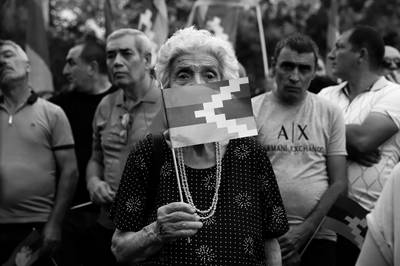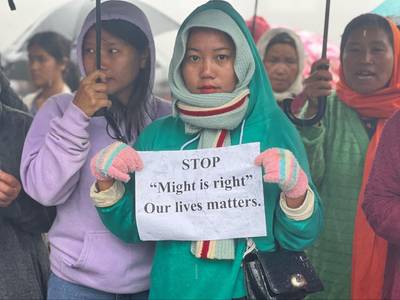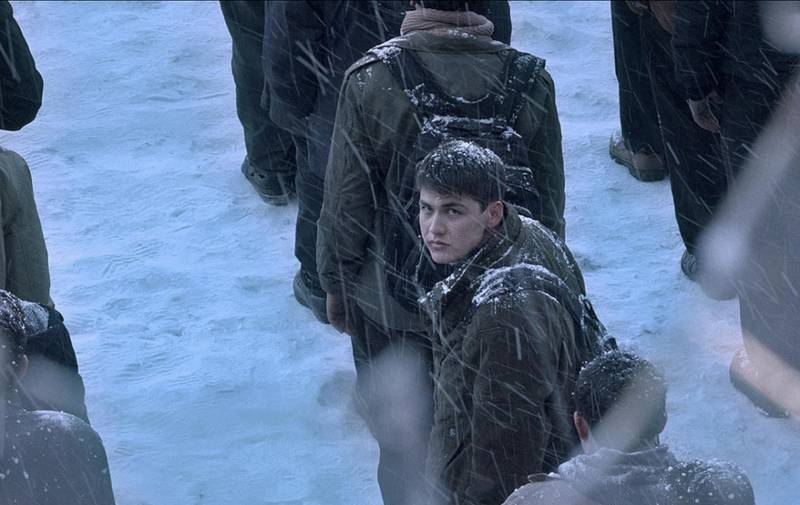

Film still from In the Land of Brothers (Dar Sarzamin-e Baradar), directed by Raha Amirfazli and Alireza Ghasemi, 2024
Mustafa Karimi is an artist and researcher in social sciences based in Tehran.
Afghanistan was built on the graves of millions of people. Its history then continued through ethnic monopolization, which gave rise to political instability, widespread massacres, and the exclusion of others. These policies ultimately led to the displacement of millions, as well as the country’s devastation and regression.
After every wave of violence and insecurity, Iran and Pakistan became the two main destinations for Afghan migration. People from southern Afghanistan, who were mostly Afghans (Pashto speakers), went to Pakistan, with which they shared religious and linguistic ties. The rest of the Afghan population, who were mostly Persian speakers, sought refuge in Iran. Among them, the Hazaras of Afghanistan—who, in addition to speaking Persian, also shared religious ties with Iran—have always chosen this country as their main destination. Throughout Afghanistan’s history, the Hazaras have been subjected to violence and massacres because of their ethnic and religious differences.
Because of the large numbers of migrations to Iran at different times, and due to the country’s limitations in managing these refugees, Iran adopted non-integrationist policies in dealing with them. These policies became the source of many events and incidents over the past several decades.
In this paper, I examine the migration experience of the Hazaras of Afghanistan in Iran. My approach is shaped by the policies outlined above and informed by a historical reading of the Hazaras’ experiences in both Afghanistan and Iran. This exploration will also extend to Iranian cinema, focusing on works of fication produced since the early 2010s that reflect and reinterpret these realities.
A Short History of the Hazaras in Afghanistan
Understanding the Hazaras’ current circumstances requires a look into history to trace their position in the land known today as Afghanistan.
Amir Abdur Rahman Khan, himself from the Afghan (Pashto-speaking) ethnic group, founded Afghanistan in the late 19th century. With British support and through the massacre of millions, he established the country’s current political borders as a colonial necessity. At that time, Russia lay to the north of present-day Afghanistan, and British India to the south. Britain constantly feared that Russia might march toward India and threaten its colonial interests. To counter this threat, the British equipped and supported Amir Abdur Rahman, who had previously worked as a British spy on the Turkestan border near Russia, to establish borders and build a centralized government.
For this project to succeed, Amir Abdur Rahman Khan needed the obedience of the various peoples in these lands. At that time, the regions largely governed themselves, each under its own Khan—the head of tribe—and some naturally resisted Kabul’s authority. With British support, the Amir began suppressing these regions, starting with Turkestan in northern Afghanistan, near Russia.
The Hazaras, who then controlled vast areas of present-day Afghanistan, were split. One faction sided with Kabul, providing soldiers to the Amir’s army and assisting in the suppression of other regions, while the larger group declared itself autonomous and refused to participate. Once the other resisting ethnic groups were defeated, the latter group of Hazaras faced retaliation. The central regions of Afghanistan—largely Hazara-inhabited and not aligned with Kabul—were besieged, and after two years of siege, the first waves of repression began.
During this suppression, the Amir’s army—composed mostly of Pashtuns—committed extreme acts of cruelty, including brutal massacres and widespread sexual violence. At this point, the Hazaras who had previously sided with the Amir’s forces broke away, joining other Hazara leaders in rebellion against his heavily armed troops, who were equipped with British-supplied weapons and artillery.
Amir Abdur Rahman Khan then sought religious sanction, obtaining a fatwa from Sunni clerics that declared the Hazaras infidels and called for a jihad against them. The decree stated that anyone participating in the war could keep the spoils—land, property, or even Hazara women—after giving a share to the government. Following this proclamation, nearly all Afghan ethnic groups, along with the nomadic Kuchis, joined the Amir’s forces. In this devastatingly unequal conflict, which lasted about nine years, the Hazaras suffered catastrophic defeats.
According to estimates drawn from official records in Siraj al-Tawarikh—a history of the Afghan state written by the Hazara scholar Fayz Mohammad Katib—over 63 percent of the Hazara population was massacred. The book notes, for example, that in Uruzgan province there were roughly 600,000 Hazara families, of which the fate of 400,000 remains unknown. The scale of the atrocities was immense, and the Hazaras endured unimaginable suffering during this period.
After this mass slaughter and ething cleansing, survivors either fled to the central mountains to escape the Amir’s forces, migrated to Iran and Pakistan, or were taken into captivity. In order to degrade and erase the dignity of the Hazaras, Amir Abdur Rahman decreed that Hazara women and children were slaves, and that anyone who captured them could keep or sell them. As a result, in the late 19th and early 20th centuries, slave markets for Hazara women and children thrived in Kabul. Fayz Mohammad Katib recounts that at the time there was hardly a household in Kabul without a Hazara woman or child enslaved.
After the Amir Abdur Rahman’s death, subsequent rulers of Afghanistan largely continued his policies until Amanullah Khan, the reformist king, came to power. Inspired by the modernization efforts of Reza Khan in Iran and Atatürk in Turkey, Amanullah sought to reform Afghan society. In 1929, he legally abolished Hazara slavery, granting the Hazara people formal freedom. Although the law changed their status, social attitudes remained deeply entrenched. Many Afghans continued to view Hazaras as socially inferior, a belief that sadly persists in some areas to this day.
Hazara Migration to Iran
Iran has long been a major destination for Afghan migrants, particularly for work. During the Pahlavi era, nearly 200,000 Afghan laborers lived in Iran, and tensions between Afghan migrants and local Iranians began to emerge. At the same time, Iranian cinema often portrayed Afghans as tribal, lawless, and unsafe. In the early 1970s, this negative depiction was largely shaped by the Cold War: Afghanistan’s governments were aligned with the Soviet Union, while the Shah of Iran aligned with the United States. These geopolitical dynamics contributed to a negative perception of Afghanistan and its people among Iranians. One example is the film Chasing to Hell (1977, Robert Eckhardt), produced under the direct orders of the Shah, depicted Afghanistan as a corridor for drug traffickers smuggling narcotics into Iran.
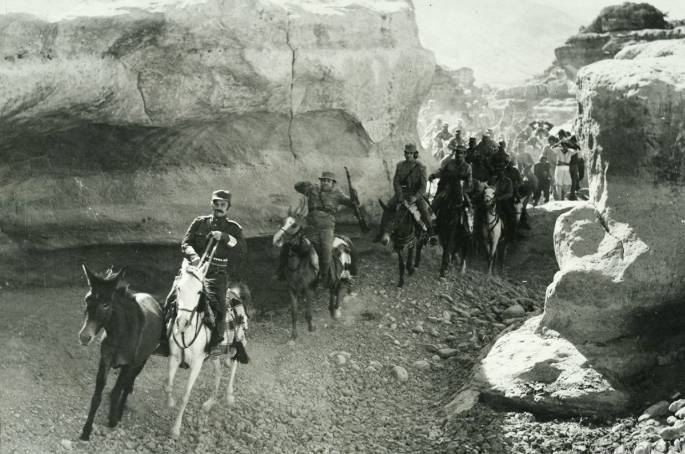

Film still from Chasing to Hell (Taghib ta Jahanam), directed by Robert Eckhardt, 1977
In the late 1970s, amid the Iranian Revolution and the establishment of a religious government—and while Afghans were resisting communist regimes—the first major wave of Afghan refugees began arriving in Iran. The Islamic Republic’s policy toward these refugees is often called the “open doors” policy. Ayatollah Khomeini famously declared, “Islam has no borders,” and Iran opened its borders to Afghans fleeing the communist government. However, the country lacked the infrastructure to manage such a massive influx, and refugees were settled primarily in urban areas.
In the early 1990s, amid Afghanistan’s civil wars, a new wave of Afghan refugees arrived in Iran, further swelling their numbers and fueling dissatisfaction among segments of the local population. From the outset of the revolution, Afghan migrants were largely regarded as temporary residents, expected to return home once the conflict in Afghanistan ended. This perspective suggested the use of camp-style settlements, but Iran lacked the infrastructure to accommodate such large numbers, and refugees instead settled in urban areas. Consequently, policies of non-integration were implemented, deliberately keeping Afghan migrants separate from Iranian society.
Iranian media, particularly cinema, played a central role in reinforcing this separation. Afghan migrants were repeatedly depicted as others of lower social and cultural status, associated with insecurity, disease, crime, and morally questionable behavior. The intent was to discourage Iranians from socializing, intermarrying, or interacting with them.
As conflict and instability in Afghanistan continued, each new wave of refugees further increased the Afghan population in Iran, and these distorted portrayals intensified. A key focus in these representations was selecting an image of Afghans that would most clearly highlight their difference from Iranians and make them immediately identifiable. The Hazara, whose features often resemble those of East Asian populations, were the most visually distinct. As a result, Hazara faces came to stand in for “Afghans” in Iranian media, including cinema, reinforcing the dehumanization perpetuated by non-integrationist policies.
The tragic irony for the Hazaras was that they faced violence both in Afghanistan and in Iran: in Afghanistan, because they were considered outsiders (recall the statement of Abdul Manan Niazi, a Taliban commander in northern Afghanistan, that “Afghanistan belongs to the Pashtuns, Tajiks should go to Tajikistan, Uzbeks to Uzbekistan, and Hazaras to the grave”), and in Iran, for being identified as Afghans, perpetuating a cycle of marginalization and violence.
Film Analysis
Next, we turn to an examination of Iranian films that reflect the policies described above. This analysis focuses on films produced between 1990-2023. From the body of films featuring Afghan characters or Afghan-related subjects, we selected those in which Afghan characters played a leading role, a significant supporting role, or had a prominent presence in the narrative. Due to the scope of this study, films in which Afghan characters appeared only briefly or in minor roles were excluded. In choosing these examples, we focused on several key themes: The portrayal of Afghans in low-status jobs, usually unskilled manual labor; The emphasis on negative representation of Afghan characters; The recurring idea of return to the homeland; and depiction of failed romances and avoidance of intermarriage between Iranians and Afghans.
Portrayal of Afghans in Low-Status Jobs
In the 2000s, Iran’s Ministry of Labour and Social Affairs published a list of occupations permitted for Afghan workers, the majority of which were low-skill jobs. In nearly all films from this period, Afghan characters were depicted in these roles, including as janitors, construction laborers, farmhands, and workers on dairy or poultry farms. Notable examples of films and the corresponding roles of Afghan characters include:
- Carriage (Kaleske), dir. Arash Moayerian, 2013 — Afghan character as an ostrich farm worker
- A Few Cubic Meters of Love (Chand Metre Moka’ab Eshgh), dir. Mahmoudi Brothers, 2013 — Afghan character as a scrap warehouse worker
- The Injured Cow (Gav-e Zakhmi), dir. Saeed Dowlatkhani, 2014 — Afghan character as a construction worker
- A Baby with Red Socks (Bache-i ba Joorab-e Ghermez), dir. Khodadad Jalali, 2017 — Afghan character as a brick kiln worker
- In the Land of Brothers (Dar Sarzamin-e Baradar), dirs. Raha Amirfazli & Alireza Ghasemi, 2024 — Afghan characters as greenhouse workers and villa caretakers
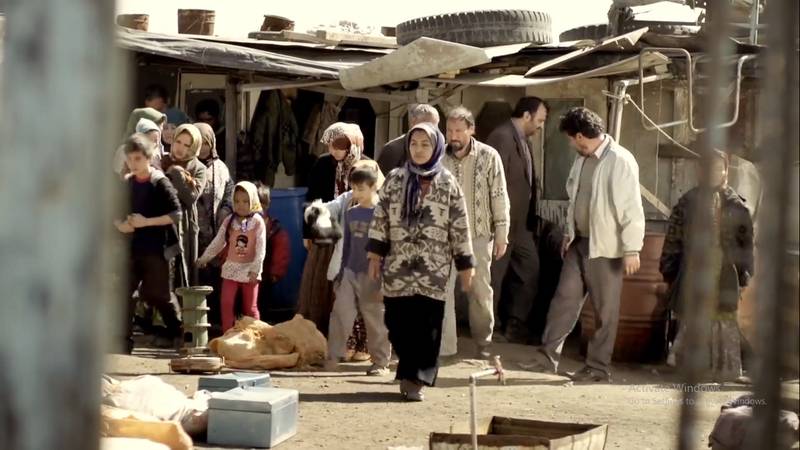

Film still from A Few Cubic Meters of Love (Chand Metre Moka’ab Eshgh), directed by the Mahmoudi Brothers, 2013
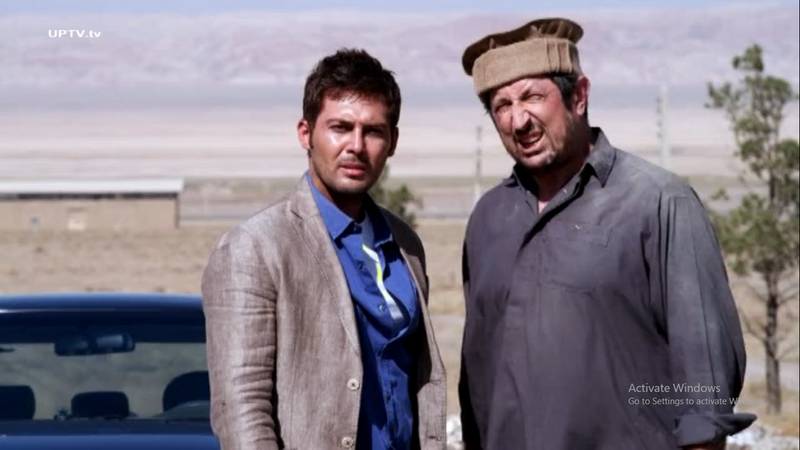

Film still from Carriage (Kaleske), directed by Arash Moayerian, 2013
In the Land of Brothers (2024), which premiered at film festivals that year, stands out as a co-production between Iran, France, and the Netherlands. Made independently and outside government institutions, it was not bound by the regulations and funding restrictions imposed on state-produced films. Yet even with this freedom, the film still reproduced long-standing stereotypes about Afghan migrants, revealing how deeply entrenched these portrayals are in Iranian society and media—where imagining Afghans all too often means reverting to clichés.
The film is composed of three episodes. In the first, a group of Afghans lives in an isolated greenhouse on the outskirts of the city, completely separated from Iranian society. The main contact is limited to two other Afghan students, with no interaction with Iranian classmates. In the second episode, a girl who has left that colony and married an Afghan man in another city appears as the caretaker of a young Iranian couple’s villa, performing tasks related to the villa and their gatherings. Although moments of warmth emerge between her and the couple, their relationship ultimately remains that of worker and employer; the Iranian couple, in the end, play the role of “generous” figures who simply pat the Afghan family’s child on the head. In the final episode, another member of the first colony is shown living on the outskirts of Karaj. Thus, the stereotype of Afghans as workers and servants is reproduced in this film, despite differences in its mode of production.
Emphasis on Negative Representation of Afghan Characters
Another recurring theme in most films is portraying Afghans as dangerous or criminal. Examples include:
- Sail and Coral (Khak-o Marjan), dir. Masoud Atyabi & Kianoush Ayari, 2013 — Afghan character as a drug trafficker
- Three Strangers (Se Biganeh), dir. Mehdi Mazloumi, 2017 — Afghan character as an American-Israeli spy, thief, and addict
- Dracula (Derakoola), dir. Reza Attaran, 2016 — Afghan character as an addict and janitor
- Chanel (Shanel), dir. Hossein Kondori, 2017 — Afghan character as a worker, thief, and nurse
Several other films reinforce this theme. In Three Strangers, a comedy, three terrorists arrive in Tehran to complete a mission and stay in a building with an Afghan janitor. Although the terrorists fail in their mission, the janitor, Jahangir Mohammad, turns out to be their main contact and is eventually arrested by Iranian police, resolving the threat. This example highlights the persistent depiction of Afghans as dangerous figures even in comedic narratives.
Emphasis on the Idea of Return to the Homeland
One of the most recurring themes in Iranian cinema regarding Afghan characters is the notion that their presence in Iran is temporary and that they must eventually return to their homeland. This idea reflects the broader approach of the Islamic Republic toward Afghan migrants, as described earlier. In films, Afghan characters are generally either deported by the police or return voluntarily. Examples include:
- A Few Cubic Meters of Love (Chand Metre Moka’ab Eshgh), dir. Mahmoudi Brothers, 2013
- Lina (Lina), dir. Ramin Rasouli, 2017
- Sun Children (Khorshid), dir. Majid Majidi, 2019
- Drowning in Holy Water (Mordan dar Abe Motahar), dir. Mahmoudi Brothers, 2019
In this context, Ramin Rasouli’s film Lina, directed by an Afghan filmmaker, is particularly significant. In the film, Hasiba Ebrahimi, an Afghan actress, is raised in an Iranian family and later discovers that she is not the biological child of that family; in her childhood, her father had entrusted her guardianship to them. At the end of the film, she abandons the entire life she has built in Iran and travels to Afghanistan to find her biological family. In the middle of the film, when Hasiba realizes she is Afghan, only then do other Afghans become visible in the city and everyday life: a worker painting a wall in a gallery, laborers constructing buildings, and so on. It is as if, while she retains her Iranian identity, these individuals exist outside the life of the Iranian person—effectively invisible—and only through her Afghan identity do they become perceptible. Afghans are exiled from the awareness of the Iranian inhabitant; not allowed to be visible within the city or living spaces of Iranians and only attain human presence among themselves.
Failed Love and the Prohibition of Intermarriage Between Iranians and Afghans
This theme may be the most politically charged in Iranian cinema. Marriage represents a significant and profound form of human connection, yet in the context of migration, it becomes an intensely forbidden domain—especially if the woman is Iranian. In such cases, crossing the boundaries of this prohibition is punishable: the children born from such marriages are penalized, and the right to Iranian citizenship is denied from them. Throughout human history, the strictest constraints have been imposed on women through their reproductive capacity, as if social organization is constantly structured around women. For example, if two warring tribes clash, offering a woman can resolve the conflict; if a woman marries a man outside her tribe, she is ostracized. Consequently, the marriage of an Iranian woman to an Afghan man is seen as nothing but ruin.
Saeed Roustaee, in this film and later in Just 6.5 (Metri Shesh o Nim), demonstrates the extent to which his cinematic vision reflects a stereotyped view of the Iranian lower class. His films are largely complicit in reproducing violence against marginalized and working-class communities. When this perspective is directed toward Afghan migrants, it perpetuates existing xenophobic and stereotypical representations of them, reinforcing discriminatory attitudes in mainstream Iranian cinema.
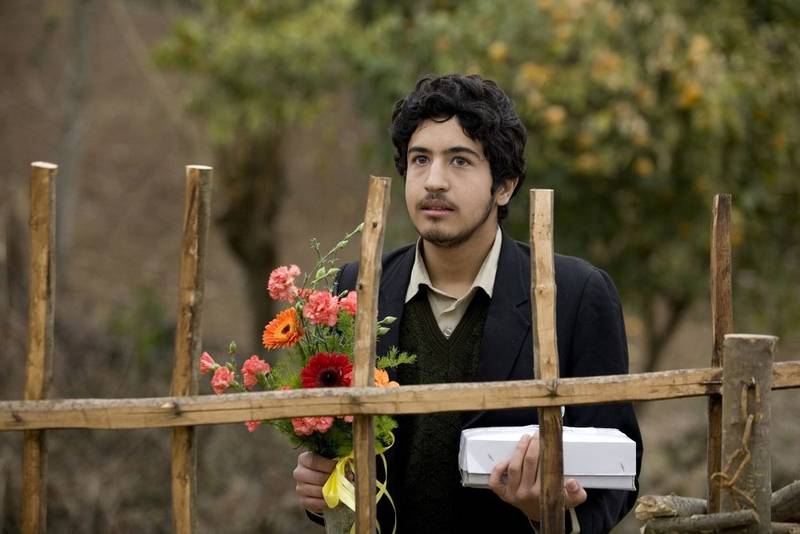

Film still from Heiran, dir. Shalizeh Arefpour, 2009
Perhaps the most notable cinematic treatment of this theme is the film Heiran, directed by Shalizeh Arefpour in 2009. In it, Zhāleh Sāmati, playing the mother of an Iranian family, declares that “even if an Afghan is the best person on earth, he is still Afghan.” The prospect of an Afghan son-in-law, regardless of his character or status, is treated as a source of shame.
Within the broader theme of unfulfilled love, the most important films of the period under study include:
- A Few Cubic Meters of Love (Chand Metre Moka’ab Eshgh), dir. Mahmoudi Brothers, 2013
- Lina (Lina), dir. Ramin Rasouli, 2017
- Tsunami, dir. Milad Sadrameli, 2018
- Sun Children (Khorshid), dir. Majid Majidi, 2019
- Shadruvan, (Shadravan) dir. Hossein Namazi, 2021
- Nasoor Road (Jadeh Nasoor), dir. Majid Boroumand, 2021
- Life and a Day (Abad va Yek Rooz), dir. Saeed Roustaee, 2015
Although in previous decades the theme of unfulfilled love generally focused on the marriage between an Iranian woman and an Afghan man, the entry of two Afghan filmmakers, Jamshid and Navid Mahmoudi—credited as the Mahmoudi Brothers—introduced changes in mainstream Iranian cinema. Perhaps because of their Afghan background, there was hope that Afghans would be depicted more humanely in their films. However, not only did their films fail to break existing stereotypes, but as Afghan filmmakers, they reinforced and reproduced prior assumptions and clichés. For instance, in A Few Cubic Meters of Love (2013), not only is marriage between an Iranian man and an Afghan woman prohibited, but the lovers’ story ends tragically. Similarly, in Lina, the Afghan girl leaves the Iranian man to return to Afghanistan. In Tsunami, the union of an Iranian boy and Afghan girl also fails. In Sun Children, the affection between an Iranian and Afghan child does not reach fulfillment, and the Afghan family eventually returns to Afghanistan.
In this context, Saeed Roustaee’s film Life and a Day (Abad va Yek Rooz) is also significant. The drama revolves around the marriage of Somayeh, a daughter of an Iranian family, to an Afghan boy. Except for the final scene, in which we see the Afghan family, the rest of the film focuses solely on the discussion of marriage to an Afghan in their absence. Despite the fact that the Afghan family is clearly in a stronger economic position than the Iranian family, and that the benefits of this marriage could alleviate some of the Iranian family’s problems, marriage to an Afghan is repeatedly depicted as a horrifying prospect.
This recalls the earlier film Hayran: even if an Afghan occupies a socially or economically high—or even higher—position, they are still regarded by the Iranian imagination as inferior, dishonorable, and incongruous. In the final scene of Life and a Day, the white-clad bride is trapped in a car between two black-clad Afghan women. A suffocating atmosphere pervades the scene; the Afghans converse inside the car while the Iranian girl remains silent, her face anxious and sorrowful, heading toward an uncertain fate.
Saeed Roustaee, in this film and later in Just 6.5 (Metri Shesh o Nim), demonstrates the extent to which his cinematic vision reflects a stereotyped view of the Iranian lower class. His films are largely complicit in reproducing violence against marginalized and working-class communities. When this perspective is directed toward Afghan migrants, it perpetuates existing xenophobic and stereotypical representations of them, reinforcing discriminatory attitudes in mainstream Iranian cinema.
Conclusion
In social psychology, the concept of historical or collective trauma refers to the complex emotional experience of a group in response to a stressful event that overwhelms its capacity to cope. Among the different types of collective trauma, the concept of ‘lethal collective trauma’ closely aligns with the experiences of the Hazaras, describing events so threatening that they cause a community to question its very ability to survive. Repeated exposure to such trauma produces intergenerational effects, shaping how individuals understand the world and the choices they make. This ongoing and intergenerational nature of trauma is essential to understanding the situation of the Hazaras, both within Afghanistan and in their experiences of migration to Iran.
Over the past century and a half, since the Hazara genocide under Amir Abdur Rahman Khan, Hazaras in Afghanistan have consistently faced violence and persecution. After the late 1970s, the first wave of Afghan migration, especially of Hazaras, to Iran removed the immediate threat of mass killing but introduced new forms of exclusion and marginalization through Iran’s non-integrationist policies. These policies, which on one level kept the Hazaras economically marginalized and on another portrayed them as socially inferior, fostered forms of resentment and hostility within Iranian society that, at critical moments, endangered their lives. Episodes of blind violence—such as the case of the “Night Bat,” an Iranian serial killer who was initially misidentified as Afghan, and the killing of Iranian diplomats in Mazar-e-Sharif during the first Taliban regime—are examples of such life-threatening moments that could revive, in the collective unconscious of the Hazaras, a deep-seated fear of collective annihilation.
In these contexts, anti-migrant violence is often targeted at those with Hazara features, pre-stereotyped and dehumanized in Iranian media, particularly cinema. This ongoing situation has, in recent years, escalated to kidnappings and killings of Hazara migrants in different cities, only some of which have been publicly reported.
A large part of Iranian society bears moral responsibility for this situation, including artists and filmmakers, in particular, independent filmmakers. Art functions both as representation and as a tool for shaping society. Independent Iranian cinema could have offered an alternative narrative to the official one, defended Afghan migrants against exclusionary policies, upheld their human dignity, and fostered a more realistic understanding among Iranians. Instead, the Afghan individual has rarely been a concern in Iranian society. At best, Afghans were viewed through a lens of charity, pity, and benevolence, a gaze that has now faded entirely, particularly after the recent twelve-day war. This shift is evident, for instance, in the decision of one of Iran’s largest charities for cancer patients to cease supporting even Afghan children with cancer.
More than four decades of negative representation of Afghans, unchallenged by any significant resistance within Iranian society, has taken its toll. The result is an exceptional degree of consensus among Iranians with the government’s approach toward Afghan refugees. The result is a humanitarian catastrophe, as people are being returned to the Taliban, the embodiment of absolute darkness.
